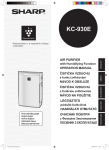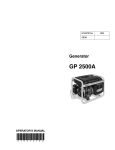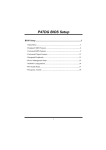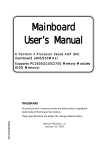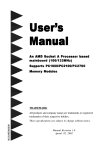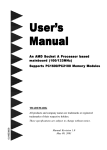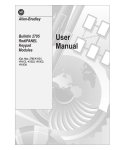Download 1791-6.5.8, Block I/O User Manual
Transcript
Block I/O Cat. No. 1791-IOBA and -IOBB Series B User Manual Important User Information Because of the variety of uses for the products described in this publication, those responsible for the application and use of this control equipment must satisfy themselves that all necessary steps have been taken to assure that each application and use meets all performance and safety requirements, including any applicable laws, regulations, codes and standards. The illustrations, charts, sample programs and layout examples shown in this guide are intended solely for example. Since there are many variables and requirements associated with any particular installation, Allen-Bradley does not assume responsibility or liability (to include intellectual property liability) for actual use based upon the examples shown in this publication. Allen-Bradley publication SGI–1.1, “Safety Guidelines For The Application, Installation and Maintenance of Solid State Control” (available from your local Allen-Bradley office) describes some important differences between solid-state equipment and electromechanical devices which should be taken into consideration when applying products such as those described in this publication. Reproduction of the contents of this copyrighted publication, in whole or in part, without written permission of Allen–Bradley Company, Inc. is prohibited. Throughout this manual we make notes to alert you to possible injury to people or damage to equipment under specific circumstances. ATTENTION: Tells readers where people may be hurt if procedures are not followed properly. ATTENTION: Tells readers where machinery may be damaged or economic loss can occur if procedures are not followed properly. Warnings and Cautions: Identify a possible trouble spot. Tell what causes the trouble. Give the result of improper action. Tell the reader how to avoid trouble. 1992 Allen-Bradley Company, Inc. PLC is a registered trademark of Allen-Bradley Company, Inc. SLC is a registered trademark of Allen-Bradley Company, Inc. Important: We recommend you frequently backup your application programs on appropriate storage medium to avoid possible data loss. II Table of Contents Important User Information . . . . . . . . . . . . . . . . . . . . . . . . I Using This Manual . . . . . . . . . . . . . . . . . . . . . . . . . . . . . . . P1 Purpose of Manual . . . . . . . . . . . . . . . . . . . . . . . . . . . . . . . . . . . Audience . . . . . . . . . . . . . . . . . . . . . . . . . . . . . . . . . . . . . . . . . . Vocabulary . . . . . . . . . . . . . . . . . . . . . . . . . . . . . . . . . . . . . . . . Manual Organization . . . . . . . . . . . . . . . . . . . . . . . . . . . . . . . . . About Block I/O . . . . . . . . . . . . . . . . . . . . . . . . . . . . . . . . . . . . . Related Publications . . . . . . . . . . . . . . . . . . . . . . . . . . . . . . . . P1 P1 P1 P1 P2 P2 Introducing Block I/O . . . . . . . . . . . . . . . . . . . . . . . . . . . . . 11 Chapter Objectives . . . . . . . . . . . . . . . . . . . . . . . . . . . . . . . . . . . General Description . . . . . . . . . . . . . . . . . . . . . . . . . . . . . . . . . . How Block I/O Fits in a PLC System . . . . . . . . . . . . . . . . . . . . . . . 11 11 12 Installing Block I/O . . . . . . . . . . . . . . . . . . . . . . . . . . . . . . . 21 Chapter Objectives . . . . . . . . . . . . . . . . . . . . . . . . . . . . . . . . . . . Pre-installation Considerations . . . . . . . . . . . . . . . . . . . . . . . . . . Installing the Block I/O . . . . . . . . . . . . . . . . . . . . . . . . . . . . . . . . Connecting Wiring . . . . . . . . . . . . . . . . . . . . . . . . . . . . . . . . . . . Remote I/O Link or Distributed I/O Link Wiring . . . . . . . . . . . . . . . Extended Node Capability . . . . . . . . . . . . . . . . . . . . . . . . . . . . . . Compatibility of 1771 I/O Products with Extended Node Numbers . . 21 21 23 23 27 29 210 Configuring Your Block I/O for PLC Family Programmable Controllers . . . . . . . . . . . . . . . 31 Chapter Objectives . . . . . . . . . . . . . . . . . . . . . . . . . . . . . . . . . . . Setting the Configuration Switches . . . . . . . . . . . . . . . . . . . . . . . . 31 31 Configuring Your Block I/O for SLC Controllers . . . . . . . . . 41 Chapter Objectives . . . . . . . . . . . . . . . . . . . . . . . . . . . . . . . . . . . Setting the Configuration Switches . . . . . . . . . . . . . . . . . . . . . . . . Addressing the Blocks Using SLC Controllers . . . . . . . . . . . . . . . . 41 41 43 Troubleshooting . . . . . . . . . . . . . . . . . . . . . . . . . . . . . . . . 51 Chapter Objectives . . . . . . . . . . . . . . . . . . . . . . . . . . . . . . . . . . . LED Indicators . . . . . . . . . . . . . . . . . . . . . . . . . . . . . . . . . . . . . . 51 51 Specifications . . . . . . . . . . . . . . . . . . . . . . . . . . . . . . . . . . A1 Preface Using This Manual Purpose of Manual This manual shows you how to use your block I/O with an Allen–Bradley programmable controller. It helps you install, program and troubleshoot your module. Audience You must be able to program and operate an Allen–Bradley programmable controller (PLC) to make efficient use of block I/O modules. We assume that you know how to do this in this manual. If you do not, refer to the appropriate PLC programming and operations manual before you attempt to program this module. Vocabulary In this manual, we refer to: the block I/O module as the “block” or the “module” the programmable controller as the “controller” Manual Organization This manual is divided into 5 chapters. The following chart shows each chapter with its corresponding title and brief overview of the topics covered in that chapter. Chapter Title Topics Covered 1 Introducing Block I/O Description of the modules, including general and hardware features 2 Installing Block I/O Module power requirements, location, and wiring information 3 Configuring Your Block I/O for PLC Family Programmable Controllers How to set the configuration switches and address the block I/O. 4 Configuring Your Block I/O for SLC Controllers How to set the switches, and where to go for full information 5 Troubleshooting How to use the indicators to troubleshoot your block I/O module. Specifications Specifications for the block I/O. Appendix A P1 Preface Using This Manual About Block I/O Block I/O consists of small, self–contained remote I/O devices complete with power supply, programmable controller interface, input/output connections and signal conditioning circuitry. Table P.A is a list of available block I/O modules. Table P.A Types of Block I/O Catalog Number Description 1791-IOBA 8 sinking inputs, 8 sourcing outputs 1791-IOBB 10 sinking inputs, 6 sourcing outputs 1791-IOVA 8 sourcing inputs, 8 sinking outputs 1791-IOVB 10 sourcing inputs, 6 sinking outputs 1791-IOBW 32 sinking inputs, 32 sourcing outputs 1791-IOVW 32 sourcing inputs, 32 sinking outputs 1791-IOBX 64 sinking inputs, 64 sourcing outputs 1791-IOVX 64 sourcing inputs, 64 sinking outputs Publication Number 1791-6 5 8 1791-6.5.8 1791-6 5 6 1791-6.5.6 1791-6 5 7 1791-6.5.7 1791-6 5 2 1791-6.5.2 This publication covers the 1791–IOBA/B and –IOBB/B block I/O modules. The 1791–IOBA/B has 8 inputs and 8 outputs; the 1791–IOBB/B has 10 inputs and 6 outputs. In all other respects, they are identical. Related Publications P2 For a list of publications with information on Allen–Bradley programmable controller products, consult our publication index (SD499). Chapter 1 Introducing Block I/O Chapter Objectives In this chapter you will learn what block I/O is, its features, and how it functions. General Description 1791–IOBA/B and –IOBB/B block I/O modules are small, self–contained remote I/O devices complete with power supply, programmable controller interface, input/output connections and signal conditioning circuitry. The 1791–IOBA/B has 8 inputs and 8 outputs; the 1791–IOBB/B has 10 inputs and 6 outputs. In all other aspects, they are identical. The blocks are compatible with PLC–2, PLC–3, and PLC–5 family programmable controllers, and the SLC 500 modular controllers. Refer to the table below for information on using block I/O with various Allen-Bradley programmable controllers. If You are Using: You must use: PLC-2 family programmable controller 1771-SN sub-I/O scanner or 1771-SD2 remote I/O scanner PLC-3 family programmable controller Block attaches directly to controller PLC-5 family programmable controller 1747-DSN scanner or 1747-SN remote I/O scanner SLC 500 programmable controller Figure 1.1 shows the physical features of the block I/O. Figure 1.1 Major Features of the Block I/O Module (1791-IOBA/B shown) DH-485 Port Switch Assemblies Status Indicators OUTPUT INPUT Removable Remote I/O Link Connector Communication LED COMM Power LED POWER Removable Input/Output Connector 10825-I 11 Chapter 1 Introducing Block I/O Wiring Connectors – Remote I/O link connector and input/output connector are removable for easy connection of wiring. Switch Assemblies – Two DIP switches are provided for setting the I/O rack number, starting I/O group, transmission rate, last chassis, last state and DH–485 terminator. Status Indicators – LED indicators display the status of communication, power and input/output. These provide a visual indication for aid in troubleshooting. DH–485 Port – A plug–in DH–485 data port is provided for use with the SLC controller. How Block I/O Fits in a PLC System Block I/O is a complete I/O interface that includes the functionality of the I/O rack, adapter, power supply, and I/O modules in a single unit. Connect sensors and actuators to the module and use the remote I/O cable to connect the block I/O to your programmable controller as shown in chapter 2. The block uses sinking inputs and sourcing outputs. In sinking inputs (Figure 1.2), the dc common is bussed on the block. and the current is sourced from the field device. The sourcing field device switches the hot side of the power supply bus causing current to flow through the sourcing device to the sinking input on the block. Figure 1.2 Sinking Input Example +V Block I/O Field Device Field Device DC Power Supply Sinking Input COM -V 10826-I 12 Chapter 1 Introducing Block I/O Sourcing outputs (Figure 1.3) have the power bussed in the block. When the output is on, current is supplied to the field control device, which sinks the current. The field circuit and the equipment remain at ground potential until the output is turned on. Figure 1.3 Sourcing Output Example Block I/O +VDC DC Power Supply Fuse Field Device Fuse Field Device -V 10827-I You connect the block I/O to your remote I/O link as you would any other device (Figure 1.4). The block looks like a 1/4 I/O rack to the processor, and uses 2 words of input image table memory and 2 words of output image table memory. The block is addressed directly on the remote I/O link. Block I/O functions exactly like any Allen–Bradley remote I/O product. Input and output data is scanned asynchronously and transferred back and forth between the block and the controller input and output image table. Figure 1.4 Block I/O Connection in a PLC System Blocks are daisy-chained to a programmable controller or a scanner. Programmable Controller or Scanner. Block I/O - each block is 1/4 I/O rack. 10828-I 13 Chapter 2 Installing Block I/O Chapter Objectives In this chapter you will learn how to mount the block, connect the remote I/O link, connect the input and output wiring to the block, and terminate the remote I/O link. Pre-installation Considerations Before installation, you must determine: the number of blocks desired the total distance of the installation transmission rate desired if external fuses are required Acceptable combinations are shown in Table 2.A. Table 2.A Acceptable Combinations of Processor and Block I/O When using and Maximum Capacity Maximum Network Distance 57.6K 10,000 cable-feet 115.2K 5,000 cable-feet 1771-SN 16 blocks with 150 ohm terminator 1772-SD 1772-SD2 1772-SD, 57.6K 16 blocks/channel, 28 blocks/scanner with 150 ohm terminator 115.2K 10,000 cable-feet Any PLC-3 scanner module 57.6K 16 blocks/channel, 64 blocks/scanner with 150 ohm terminator 115.2K 10,000 cable-feet PLC-2 family 57.6K PLC-3 family 1775-S5, or -SR5 module PLC-55 family PLC Baud Rate Used 5,000 cable-feet 5,000 cable-feet 10,000 cable-feet / / 32 blocks/channel, 64 blocks/scanner 115.2K with 82 ohm terminator 5,000 cable-feet 230.4K 2,000 cable-feet PLC-5/15 12 blocks with 150 ohm terminator 57.6K 10,000 cable-feet PLC-5/25 16 blocks with 150 ohm terminator, 28 blocks with 82 ohm terminator 57.6K 10,000 cable-feet PLC-5/30 16 blocks/channel, 28 blocks per processor with 150 ohm terminator 57.6K 10,000 cable-feet 115.2K 5,000 cable-feet 21 Chapter 2 Installing Block I/O When using PLC-5 family (continued) and PLC-5/30 Maximum Capacity / 28 blocks/channel, 28 blocks per processor with 82 ohm terminator 16 blocks/channel, 32 blocks per processor with 150 ohm terminator PLC-5/40L, PLC-5/60L / 32 blocks/channel, 60 blocks per processor with 82 ohm terminator 16 blocks/channel, 60 blocks per processor with 150 ohm terminator PLC-5/40, PLC-5/60 / 32 blocks/channel, 60 blocks per processor with 82 ohm terminator 16 blocks/channel, 32 blocks/scanner 64 blocks/(2 blocks/scanner, scanners) with 150 ohm terminator PLC-5250 PLC 5250 - requires i a 55150-RS 50 S remote e o e sca scanner e 32 blocks/channel blocks/channel, 32 blocks/scanner, 64 blocks/(2 scanners) with 82 ohm terminator Baud Rate Used Maximum Network Distance 57.6K 10,000 cable-feet 115.2K 5,000 cable-feet 230.4K 2,500 cable-feet 57.6K 10,000 cable-feet 115.2K 5,000 cable-feet 57.6K 10,000 cable-feet 115.2K 5,000 cable-feet 230.4K 2,500 cable-feet 57.6K 10,000 cable-feet 115.2K 5,000 cable-feet 57.6K 10,000 cable-feet 115.2K 5,000 cable-feet 230.4K 2,500 cable-feet 57.6K 10,000 cable-feet 115.2K 5,000 cable-feet 57.6K 10,000 cable-feet 115.2K 5,000 cable-feet 230.4K 2,500 cable-feet SLC-5/01 Controller 1747-DSN Scanner module* 7 blocks 230.4K 2,500 cable-feet SLC-5/02 Controller 1747-DSN Scanner module* 30 blocks 230.4K 2,500 cable-feet 57.6K 10,000 cable-feet 115.2K 5,000 cable-feet 230.4K 2,500 cable-feet SLC-5/02 Controller S Remote I/O /O 1747-SN Module Scanner Module* 16 blocks * The DH-485 network, which operates independent of the remote I/O/distributed I/O network, supports up to 30 DH-485 nodes (blocks or 1747-AIC isolated couplers). The maximum DH-485 network distance is 4,000 cable-feet. 22 Chapter 2 Installing Block I/O Installing the Block I/O Figure 2.1 shows the mounting dimensions for the block I/O module. Mount the blocks horizontally with a minimum of 2” between blocks. This air gap is necessary to maintain proper cooling air flow through the block. Figure 2.1 Mounting Dimensions for the Block I/O Module (Cat. No. 1791-IOBA/B and -IOBB/B) 10mm 0.39" Depth = 96.0mm (3.78") 8mm 0.31" 198mm 7.8" OUTPUT COMM POWER INPUT 35mm 1.37" 10mm 0.39" 180mm 7.1" 16mm 0.63" 16mm 0.63" 212mm 8.35" 10829-I The operating temperature in the air gap between block I/O modules must not exceed 55oC (151oF). Figure 2.2 shows the dimensions of the required air gap. Figure 2.2 Clearance Required for Block I/O Modules 51mm 2" OUTPUT COMM POWER INPUT 51mm 2" 51mm 2" 51mm 2" 10830-I Connecting Wiring Connections to the block I/O module are made to the removable connectors which plug into the front of the block. The connector blocks are keyed to prevent incorrect insertion and are secured by screws. Wiring for the block is shown in Figure 2.3 and Figure 2.4. Remote I/O wiring connections are shown in Figure 2.5. 23 Chapter 2 Installing Block I/O Figure 2.3 Input and Output Connections for the 1791-IOBA/B 8 OUTPUTS 2 SHD 1 B A COM +24 DCN CG 8 INPUTS VDC O0 O1 O2 O3 O4 O5 O6 O7 I0 I1 I2 I3 I4 I5 I6 I7 COM Remote DH-485 I/O Link (for SLC (see Figure 2.5) only) +24V dc dc Neutral Chassis Ground Input Common Output +Vdc INPUT 7 INPUT 6 INPUT 5 INPUT 4 INPUT 3 INPUT 2 INPUT 1 INPUT 0 OUTPUT 0 OUTPUT 1 OUTPUT 2 OUTPUT 3 OUTPUT 4 OUTPUT 5 OUTPUT 6 OUTPUT 7 10831-I Figure 2.4 Input/Output Wiring Connections for the 1791-IOBB/B 10 INPUTS 6 OUTPUTS 2 SHD 1 B A COM +24 DCN CG Remote I/O Link DH-485 (for SLC only) +24V dc dc Neutral Chassis Ground 24 VDC O0 O1 O2 O3 O4 O5 I0 I1 I2 I3 I4 I5 I6 I7 I8 I9 COM Input Common Output +Vdc OUTPUT 0 OUTPUT 1 OUTPUT 2 OUTPUT 3 OUTPUT 4 OUTPUT 5 INPUT 9 INPUT 8 INPUT 7 INPUT 6 INPUT 5 INPUT 4 INPUT 3 INPUT 2 INPUT 1 INPUT 0 Chapter 2 Installing Block I/O Table 2.B Wiring Block Designations 1791-IOBA Connector Remote I/O Connector I/O Connector Designation 1791-IOBB Description Designation Description 1 Blue wire - RIO 1 Blue wire - RIO 2 Clear wire - RIO 2 Clear wire - RIO SHD Shield - RIO SHD Shield - RIO A DH-485 A A DH-485 A B DH-485 B B DH-485 B COM DH-485 Common COM DH-485 Common +24 +24V dc +24 +24V dc DCN dc neutral DCN dc neutral CG Chassis ground CG Chassis ground VDC Output supply VDC Output supply O0 thru O7 Output 0 thru 7 O0 thru O5 Output 0 thru 5 I0 thru I7 Input 0 thru 7 I0 thru I9 Input 0 thru 9 COM Input common COM Input common Power Supply Requirements An external 24V dc power supply is required to power the block. Total current required to power the block is equal to 200mA plus an inrush of 5.5A for 10µsec for each block. The supply must be able to source an additional 100mA plus an inrush current of 400mA when a peripheral is connected. In addition, the external power supply should have current limiting capabilities. The voltage range must not exceed 20.5–27.6V dc. 25 Chapter 2 Installing Block I/O Wiring Requirements Table 2.C shows the wiring cable requirements for the 1791–IOBA/B and 1791–IOBB/B modules. Table 2.C Acceptable Wiring Cables for Block I/O Connection Use Cable Type With Remote I/O Link or DIO Link Belden 9463 PLC-2, PLC-3, PLC-5 family programmable controllers and SLC controllers DH-485 Data Link Belden 9842 SLC controllers only Input and Output wiring Up to 14AWG Stranded with 3/64 inch insulation All Figure 2.5 Remote I/O Link Wiring Tighten screw to clamp wire. Connection 1 Clear wire Blue wire Shield wire X 2 SHD X Clear X Shield 26 Blue 10832-I Chapter 2 Installing Block I/O Remote I/O Link or Distributed I/O Link Wiring Blocks must be wired in series as shown in Figure 2.6 or Figure 2.7. Do not attempt to wire any block in parallel. The number of blocks used depends not only on the user requirements but also on the system used. Refer to Table 2.A (page 2-1) for maximum block usage for individual systems. Figure 2.6 Series Connection for Block I/O Using PLC-2, PLC-3 or PLC-5 Family Programmable Controllers To Programmable Controller or I/O Scanner Module 1 I/O Rack 1 I/O Rack 1 I/O Rack 1 I/O Rack Install terminating resistor on last block. 10833-I 27 Chapter 2 Installing Block I/O Figure 2.7 Series Configurations for Block I/O Using the SLC Programmable Controller To 1747-DSN Scanner Module Up to 7 blocks using SLC-5/01 Processor To 1747-DSN Scanner Module 1 Install terminating resistor on last block. 2 29 30 To 1747-SN Scanner Module Up to 30 blocks with SLC-5/02 Install terminating resistor on last block. 1 2 15 16 Install terminating resistor on last block. Up to 16 blocks with SLC-5/02 10834-I 28 Chapter 2 Installing Block I/O Termination Resistor A termination resistor must be installed on the last block in a series. Connect the resistor as shown in Figure 2.8. Use the resistor as identified in Table 2.D. Figure 2.8 Installing the Termination Resistor Tighten screw to clamp wires and termination resistor. Connect termination resistor across terminals 1 and 2 Termination Resistor 10835-I Table 2.D Terminator Requirements System PLC-2, PLC-3, PLC-5 family, SLC 500 family Extended Node Capability Terminator Resistor 150 ohm - 57.6K and 115.2K baud 82 ohm - 230.4K baud If this is the last remote I/O adapter on the remote I/O link in a PLC system, you must use a terminating resistor to terminate both ends of the remote I/O link (scanner end and last block end). The size of the terminator is determined by the system configuration. Older configurations can use a 150 ohm resistor at both ends. With newer devices that can support it, you can use an 82 ohm termination resistor at both ends. The 82 ohm terminators provide “extended node” capability which allows you to have up to 32 physical devices on the remote I/O link. (The number of logical racks capable of being addressed by the scanner is not affected.) ATTENTION: Devices that are operating at 230.4K baud must have 82 ohm terminators in place for proper operation. 29 Chapter 2 Installing Block I/O Compatibility of 1771 I/O Products with Extended Node Numbers Certain products are not compatible with extended node capabilities obtained with the use of 82 ohm terminators. Table 2.E lists those products that are not compatible. Table 2.E Non-compatible Products Device Scanners - Adapters - Miscellaneous - 210 Series 1771-SN All 1772-SD All 1772-SD2 All 1775-SR All 1775-S4A All 1775-S4B All 1771-AS All 1771-ASB Series A 1771-DCM All 1771-AF All 1771-AF1 All Chapter 3 Configuring Your Block I/O for PLC Family Programmable Controllers Chapter Objectives In this chapter you will learn how to configure your block I/O when used with PLC family programmable controllers. This includes the following: setting the configuration switches addressing the block I/O Setting the Configuration Switches Each block I/O module has two 6–position DIP switches for setting: starting I/O group I/O rack number transmission (baud) rate last chassis last state DH–485 terminator These switches are accessible by opening the door on the left side of the module (Figure 3.1). 31 Chapter 3 Configuring Your Block I/O for PLC Family Programmable Controllers Figure 3.1 Switch Settings for 1791-IOBA/B and -IOBB/B S1 S2 OUTPUT COMM POWER INPUT Baud Rate 0 2 4 6 Switch 1 2 On (Closed) On (Closed) Off (Open) On (Closed) On (Closed) Off (Open) Off (Open) Off (Open) OPEN 3 4 5 6 OPEN Last State 4 Reset to 0 Off (Open) Hold last state On (Closed) Not Used Last Chassis Switch as viewed from this end. 3 Yes Off (Open) No On (Closed) DH-485 Terminate None Off = Open On = Closed 1 Off (Open) On (Closed) Table 3.A Addressing PLC-2 Family Processors 32 6 On (Closed) Off (Open) Off (Open) On (Closed) On (Closed) On (Closed) 230.4K 115.2K 57.6K S2 1 2 Starting I/O Group 1 2 I/O Rack Number Switches 3-6 (see Table 3.A, B and C) 3 4 5 6 S1 5 Switch Number I/O Rack Number 3 4 5 6 1 On (Closed) On (Closed) On (Closed) On (Closed) 2 Off (Open) On (Closed) On (Closed) On (Closed) 3 On (Closed) Off (Open) On (Closed) On (Closed) 4 Off (Open) Off (Open) On (Closed) On (Closed) 5 On (Closed) On (Closed) Off (Open) On (Closed) 6 Off (Open) On (Closed) Off (Open) On (Closed) 7 On (Closed) Off (Open) Off (Open) On (Closed) 10836-I Chapter 3 Configuring Your Block I/O for PLC Family Programmable Controllers Table 3.B Addressing PLC-3 and PLC-5/250 Processors I/O Rack Number 3 Switch Number 4 5 6 I/O Rack Number 3 0 On (Closed) On (Closed) 1 Off (Open) 2 Switch Number 4 5 On (Closed) On (Closed) 10 On (Closed) On (Closed) On (Closed) Off (Open) On (Closed) On (Closed) On (Closed) 11 Off (Open) On (Closed) On (Closed) Off (Open) On (Closed) Off (Open) On (Closed) On (Closed) 12 On (Closed) Off (Open) On (Closed) Off (Open) 3 Off (Open) Off (Open) On (Closed) On (Closed) 13 Off (Open) Off (Open) On (Closed) Off (Open) 4 On (Closed) On (Closed) Off (Open) On (Closed) 14 On (Closed) On (Closed) Off (Open) Off (Open) 5 Off (Open) On (Closed) Off (Open) On (Closed) 15 Off (Open) On (Closed) Off (Open) Off (Open) 6 On (Closed) Off (Open) Off (Open) On (Closed) 16 On (Closed) Off (Open) Off (Open) Off (Open) 7 Off (Open) Off (Open) Off (Open) On (Closed) 17 Off (Open) Off (Open) Off (Open) Off (Open) 6 Table 3.C Addressing PLC-5 I/O Processors I/O Rack Number 3 Switch Number 4 5 6 I/O Rack Number 3 01 Off (Open) On (Closed) 02 On (Closed) 03 Off (Open) On (Closed) On (Closed) 10 On (Closed) On (Closed) On (Closed) Off (Open) Off (Open) On (Closed) On (Closed) 11 Off (Open) On (Closed) On (Closed) Off (Open) Off (Open) On (Closed) On (Closed) 12 On (Closed) Off (Open) On (Closed) Off (Open) 13 Off (Open) Off (Open) On (Closed) Off (Open) PLC-5/15 processors can scan racks 01-03 Switch Number 4 5 6 04 On (Closed) On (Closed) Off (Open) On (Closed) 14 On (Closed) On (Closed) Off (Open) Off (Open) 05 Off (Open) On (Closed) Off (Open) On (Closed) 15 Off (Open) On (Closed) Off (Open) Off (Open) 06 On (Closed) Off (Open) Off (Open) On (Closed) 16 On (Closed) Off (Open) Off (Open) Off (Open) 07 Off (Open) Off (Open) Off (Open) On (Closed) 17 Off (Open) Off (Open) Off (Open) Off (Open) PLC-5/25 processors can scan racks 01-07 PLC-5/40 and 5/60 processors can scan racks 01-17 Each block uses 2 words of output image table memory and 2 words of input image table memory. Each block occupies 1/4 rack of data table, with 4 blocks comprising 1 logical rack. Image table usage for one assigned rack number is shown in Figure 3.2 (IOBA) and Figure 3.4 (IOBB). An example of image table usage is shown in Figure 3.3 (IOBA) and Figure 3.5 (IOBB). 33 Chapter 3 Configuring Your Block I/O for PLC Family Programmable Controllers Figure 3.2 I/O Image Table for One Assigned Rack Number with 1791-IOBA/B Input Image 10 7 Reserved Reserved Reserved Reserved Reserved Reserved Reserved Reserved 17 0 1 2 3 4 5 6 7 1791-IOBA/B 1791-IOBA/B 1791-IOBA/B Rack 1 1791-IOBA/B Output Image 10 7 Reserved Reserved Reserved Reserved Reserved Reserved Reserved Reserved 17 0 1 2 3 4 5 6 7 0 0 For 1791-IOBA/B - 7-0 input and 7-0 output image bits 10837-I Figure 3.3 Input Table Usage Example for One Starting I/O Group with 1791-IOBA/B PLC-2 Example 1 1 0 00 PLC-3, PLC-5, PLC-5/250 Example Type of I/O I/O Group Number 110 I/O Bit I/O Group Number I/O Rack Number Reserved Reserved 11 10 7 6 5 4 3 2 1 0 2 1 0 Input Image Block Data 010 011 34 I = Input O = Output I/O Bit I/O Rack Number 111 1 0 00 Type of I/O 1 = Input 0 = Output Starting I/O Group 0 I Reserved Reserved 11 10 7 6 5 4 3 Block Data Output Image 10838-I Chapter 3 Configuring Your Block I/O for PLC Family Programmable Controllers Figure 3.4 I/O Image Table for One Assigned Rack Number with 1791-IOBB/B Input Image 10 7 Reserved Reserved Reserved Reserved Reserved Reserved Reserved Reserved 17 0 1 2 3 4 5 6 7 1791-IOBB/B 1791-IOBB/B 1791-IOBB/B 1 I/O Rack 1791-IOBB/B Output Image 10 7 Reserved Reserved Reserved Reserved Reserved Reserved Reserved Reserved 17 0 1 2 3 4 5 6 7 0 0 For 1791-IOBB/B - 11-0 input and 5-0 output image bits Figure 3.5 Input Table Usage Example for One Starting I/O Group with 1791-IOBB/B PLC-2 Example 1 1 2 00 PLC-3, PLC-5, PLC-5/250 Example Type of I/O I/O Group Number 112 I/O Bit I/O Group Number I/O Rack Number Reserved Reserved 11 10 7 6 5 4 3 2 1 0 2 1 0 Input Image Block Data 012 013 I = Input O = Output I/O Bit I/O Rack Number 113 1 2 00 Type of I/O 1 = Input 0 = Output Starting I/O Group 2 I Reserved Reserved 11 10 7 6 5 4 3 Output Image Block Data 35 Chapter 4 Configuring Your Block I/O for SLC Controllers Chapter Objectives In this chapter you will learn how to configure your block I/O when used with SLC family controllers. This includes the following: setting the configuration switches addressing the block I/O Refer to publication 1747–NM004 Series A, “Distributed I/O Scanner,“ and publication 1747–NM005 Series A, “RIO Scanner” for complete information on switch settings and addressing of the block I/O. Setting the Configuration Switches Each block I/O module has two 6–position DIP switches for setting: block address transmission (baud) rate last state or reset DH–485 termination These switches are accessible by opening the door on the left side of the module (Figure 4.1). 41 Chapter 4 Configuring Your Block I/O for SLC Controllers Figure 4.1 Switch Settings for Block I/O when used with the SLC 500 Controller S1 S2 OUTPUT COMM POWER INPUT 1-7 1-15 17-31 Switches 1-6 100000 to 111000 100000 to 111100 100010 to 111110 OPEN 3 4 5 6 OPEN S2 1 2 Block Addresses 1 2 3 4 5 6 S1 Switch as viewed from this end. Baud Rate 5 6 230.4K On (0) Off (1) Hold Last State Not Used Reset to 0 4 Off (1) Hold last state On (0) DH-485 Terminate None 1 On (0) Off (1) Off = Open = 1 On = Closed = 0 42 10839-I Chapter 4 Configuring Your Block I/O for SLC Controllers Table 4.A Addressing SLC 500 Controllers Block Address 1 2 6 Block Address 1 2 1 Off (1) On (0) On (0) On (0) On (0) On (0) 17 Off (1) On (0) On (0) On (0) Off (1) On (0) 2 On (0) Off (1) On (0) On (0) On (0) On (0) 18 On (0) Off (1) On (0) On (0) Off (1) On (0) 3 Off (1) Off (1) On (0) On (0) On (0) On (0) 19 Off (1) Off (1) On (0) On (0) Off (1) On (0) 4 On (0) On (0) Off (1) On (0) On (0) On (0) 20 On (0) On (0) Off (1) On (0) Off (1) On (0) 5 Off (1) On (0) Off (1) On (0) On (0) On (0) 21 Off (1) On (0) Off (1) On (0) Off (1) On (0) 6 On (0) Off (1) Off (1) On (0) On (0) On (0) 22 On (0) Off (1) Off (1) On (0) Off (1) On (0) 7 Off (1) Off (1) Off (1) On (0) On (0) On (0) 23 Off (1) Off (1) Off (1) On (0) Off (1) On (0) 8 On (0) On (0) On (0) Off (1) On (0) On (0) 24 On (0) On (0) On (0) Off (1) Off (1) On (0) 9 Off (1) On (0) On (0) Off (1) On (0) On (0) 25 Off (1) On (0) On (0) Off (1) Off (1) On (0) 10 On (0) Off (1) On (0) Off (1) On (0) On (0) 26 On (0) Off (1) On (0) Off (1) Off (1) On (0) 11 Off (1) Off (1) On (0) Off (1) On (0) On (0) 27 Off (1) Off (1) On (0) Off (1) Off (1) On (0) 12 On (0) On (0) Off (1) Off (1) On (0) On (0) 28 On (0) On (0) Off (1) Off (1) Off (1) On (0) 13 Off (1) On (0) Off (1) Off (1) On (0) On (0) 29 Off (1) On (0) Off (1) Off (1) Off (1) On (0) 14 On (0) Off (1) Off (1) Off (1) On (0) On (0) 30 On (0) Off (1) Off (1) Off (1) Off (1) On (0) 15 Off (1) Off (1) Off (1) Off (1) On (0) On (0) 31 Off (1) Off (1) Off (1) Off (1) Off (1) On (0) 16 Addressing the Blocks Using SLC Controllers Switch S1 Positions 3 4 5 Switch S1 Positions 3 4 5 6 Invalid The SLC controller communicates with the block I/O using a Distributed I/O Scanner module (cat. no. 1747–DSN) or an RIO Scanner module (cat. no. 1747–SN). The 1747–DSN scanner can address up to 7 blocks using an SLC 5/01 Controller, and up to 30 blocks using an SLC 5/02 Controller. The 1747–SN scanner, only used with the SLC 5/02 processor, can address 16 blocks. When used with the Distributed I/O Scanner module, block addresses must be contiguous. The actual number of blocks to which the 1747–DSN scanner module will communicate is determined when programming the SLC controller. Refer to publication 1747–NM004 Series A, “Distributed I/O Scanner,“ and publication 1747–NM005 Series A, “RIO Scanner” for complete information on switch settings and addressing of the block I/O. 43 Chapter 5 Troubleshooting Chapter Objectives In this chapter you will learn about the LED indicators on the block I/O module, and how to use them to troubleshoot the unit. LED Indicators Each block I/O module has LED indicators (Figure 5.1) which provide indication of module status. Each module has the following: green communication indicator – indicates whether communication is occurring between processor or scanner and the block. red power indicator – indicates if power is applied to module and internal hardware status 16 I/O status indicators (8 input–8 output or 10 input–6 output) – reflect the state of the individual inputs and outputs (on or off) Figure 5.1 shows the location of the indicators. Refer to Table 5.A for status indications reported by the indicators. Figure 5.1 Indicators on the Block I/O Module (1791-IOBA/B shown) Status Indicators OUTPUT INPUT Communication LED (green) Power LED (red) COMM POWER 10846-I 51 Chapter 5 Troubleshooting Table 5.A Troubleshooting Chart Indication Probable Cause Corrective Action Green COMM LED on Red POWER LED on I/O status LED on/off Normal indication None required Red POWER LED flashing Block failed self-test, or a major fault is detected. Cycle power to the block. If problem persists, replace the block. Red POWER LED off No 24V dc power connected, or hardware fault. Check 24V dc power to block Green COMM LED off No communication with processor, scanner etc. Check that power LED is on. Make sure that proper number of blocks are configured. Check remote I/O link or distributed I/O link wiring. Reset command (or output disable bit for SLC) has been issued by processor or scanner. Check program. Correct as necessary. SLC or programmable controller not in run mode. Place in run mode. Green COMM LED flashing 52 Appendix A Specifications General Specifications External power Environmental Conditions Operating Temperature Storage Temperature Relative Humidity Conductors Wire Size 200mA @ 24V dc; initial surge 5.5A for 10µsec. The supply must be able to source an additional 100mA plus an inrush current of 400mA when a peripheral is connected. 32 to 131oF (0 to 55oC) -40 to 185oF (-40 to 85oC) 5 to 95% noncondensing 14 gauge stranded (maximum) 3/64 inch insulation (maximum) Power Dissipation IOBA/B: 13.94 Watts (maximum); 9.62 Watts (typical) IOBB/B: 13.05 Watts (maximum); 8.92 Watts (typical) Thermal Dissipation IOBA/B: 47.7 BTU/hr (maximum); 32.9 BTU/hr (typical) IOBB/B: 44.6 BTU/hr (maximum); 30.5 BTU/hr (typical) Remote I/O Isolation 850V dc (transformer) for 1 second DH-485 Isolation 850V dc (optocoupler) for 1 second Interconnect cable length RIO: PLC SLC DH-485 Cable requirements 57.6K 10,000 cable-feet 115.2K 5,000 cable-feet 230.4K 2,500 cable-feet 230.4K 2,500 cable-feet 4000 ft (1219 meters) RIO/DIO - Belden 9463 DH-485 - Belden 9842 1791-IOBA/B Input Specifications Number of Inputs 8 Input type Sinking Input voltage range 20.5 to 27.6V dc On-state input current 6.5mA (minimum) @ 20.5V dc On-state input voltage 20.5V dc (minimum) Off-state voltage 6.0V dc (maximum) Off-state current 1.5mA dc (maximum) Turn On time 1.5msec (maximum) Turn Off time 1.0msec (maximum) A1 Appendix A Specifications 1791-IOBA/B Output Specifications Number of outputs 8 Output type Source Rated output voltage 10 to 30V dc Maximum on-state voltage drop 1.5V dc @ 25oC Maximum on-state current 0.5A Minimum on-state current 15mA Surge Current 3.0A for 10ms (maximum), 1 pulse per second max. Off-state voltage 30V dc (maximum) Off-state leakage current 0.5mA (maximum) Turn on time 0.5ms (maximum) Turn off time 1ms (maximum) 1791-IOBB/B Input Specifications A2 Number of Inputs 10 Input type Sinking Input voltage 20.5 to 27.6V dc On-state input voltage 20.5V dc (minimum) On-state input current 6.5mA (minimum) @ 20.5V dc Off-state voltage 6.00V dc (maximum) Off-state current 1.5mA dc (maximum) Turn On time 1.5msec (maximum) Turn Off time 1.0msec (maximum) Appendix A Specifications 1791-IOBB/B Output Specifications Number of outputs 6 Output type Source Rated output voltage 10 to 30V dc Maximum on-state voltage drop 1.5V dc @ 25oC Maximum on-state current 0.5A Minimum on-state current 15mA Surge Current (maximum) 3.0A for 10ms (max), 1 pulse per second max. Off-state voltage 30V dc (maximum) Off-state leakage current 0.5mA (maximum) Turn on time 0.5ms (maximum) Turn off time 1ms (maximum) A3 Index B block addressing, SLC, 43 C compatibility, extended node numbers, 210 configuration switches, 31 SLC, 41 M mounting dimensions, 23 P power supply requirements, 25 R connecting block I/O, in a PLC system, 13 related publications, P2 connecting wiring, 23 1791-IOBA, 24 1791-IOBB, 24 remote I/O link connector, 12 D description, P2, 11 DH-485 port, 12 E extended node capability, 29 remote I/O link wiring, 27 S series connections PLC-2, PLC-3 and PLC-5, 27 SLC, 28 sinking inputs, 12 description, 12 sourcing outputs, 12 description, 13 specifications, A1 F features, 11 I I/O rack addressing PLC-2 family, 32 PLC-3 and PLC-5/250, 33 PLC-5, 33 image table usage, 33 1791-IOBA, 34 1791-IOBB, 35 status indicators, 12 switch assemblies, 12 T termination resistor, 29 troubleshooting chart, 52 Types of block I/O, P2 types of block I/O, 11 W wiring cable, 26 L LED indicators, 51 wiring connections, definitions, 25 With offices in major cities worldwide WORLD HEADQUARTERS Allen-Bradley 1201 South Second Street Milwaukee, WI 53204 USA Tel: (1) 414 382-2000 Telex: 43 11 016 FAX: (1) 414 382-4444 EUROPE/MIDDLE EAST/AFRICA HEADQUARTERS Allen-Bradley Europe B.V. Amsterdamseweg 15 1422 AC Uithoorn The Netherlands Tel: (31) 2975/43500 Telex: (844) 18042 FAX: (31) 2975/60222 As a subsidiary of Rockwell International, one of the world’s largest technology companies — Allen-Bradley meets today’s challenges of industrial automation with over 85 years of practical plant-floor experience. More than 11,000 employees throughout the world design, manufacture and apply a wide range of control and automation products and supporting services to help our customers continuously improve quality, productivity and time to market. These products and services not only control individual machines but integrate the manufacturing process, while providing access to vital plant floor data that can be used to support decision-making throughout the enterprise. ASIA/PACIFIC HEADQUARTERS Allen-Bradley (Hong Kong) Limited Room 1006, Block B, Sea View Estate 28 Watson Road Hong Kong Tel: (852) 887-4788 Telex: (780) 64347 FAX: (852) 510-9436 CANADA HEADQUARTERS Allen-Bradley Canada Limited 135 Dundas Street Cambridge, Ontario N1R 5X1 Canada Tel: (1) 519 623-1810 FAX: (1) 519 623-8930 LATIN AMERICA HEADQUARTERS Allen-Bradley 1201 South Second Street Milwaukee, WI 53204 USA Tel: (1) 414 382-2000 Telex: 43 11 016 FAX: (1) 414 382-2400 Publication 1791–6.5.8 – April 1992 P/N 955112–02 Supersedes publication 1791–6.5.8 – March 1992 Copyright 1992 Allen-Bradley Company, Inc. Printed in USA




































